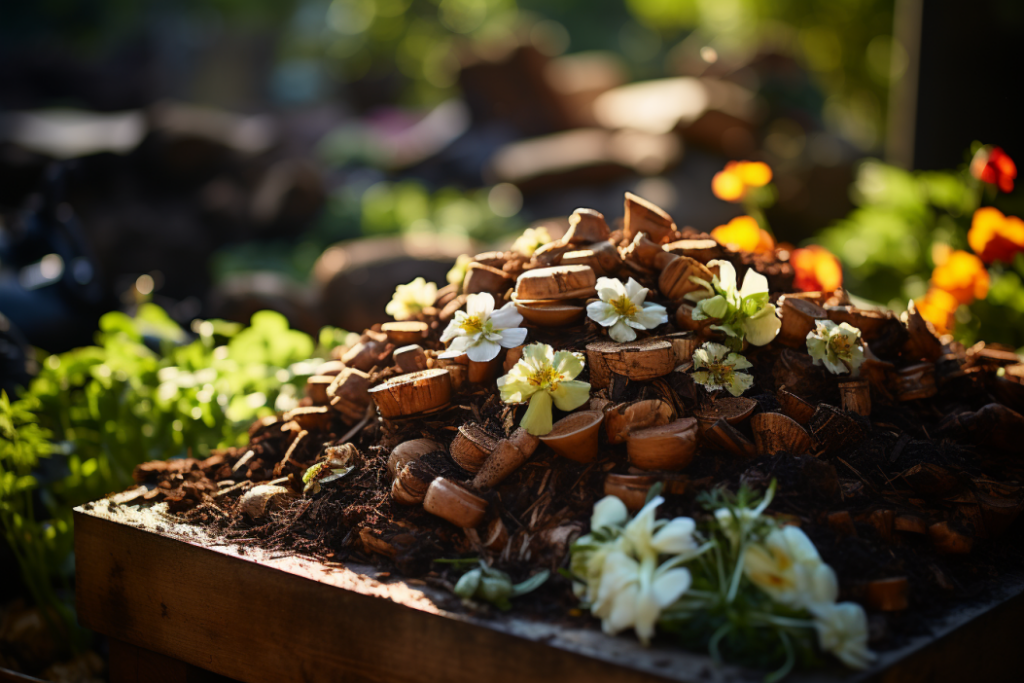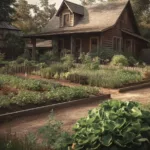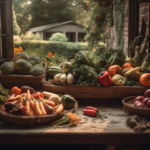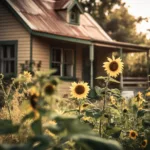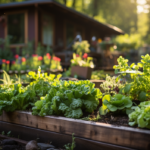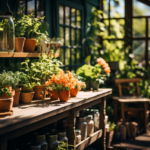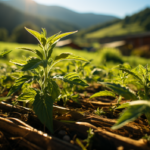Table of Contents
Boost Your Garden’s Health and Sustainability with DIY Composting Methods
Hey there! Are you an avid gardener looking for ways to improve the health and sustainability of your kitchen garden? If you haven’t considered composting yet, you’re missing out on a powerful tool to enhance your gardening game.
Creating compost is a lot easier than you might think and has numerous benefits for both your garden and the environment. By transforming your organic waste into a rich nutrient source, you can improve soil quality, increase plant growth, and reduce landfill waste.
In this article, we’ll show you how to make compost for your kitchen garden, step by step. We’ll cover everything from the basics of composting to more advanced techniques. Whether you have a big backyard or a small balcony, you can easily create a compost bin that suits your needs.
So grab your gardening gloves and let’s get started on creating a healthier, happier garden with homemade compost!
Types of Composting Bins
Types of Composting Bins
When it comes to creating compost, there is no “one size fits all” solution. The type of composting bin you choose will depend on the amount of space you have available, what type of waste you want to compost, and how much effort you want to put into managing the composting process.
Here are some of the most common types of composting bins to consider:
- Traditional Composting Bin: This type of bin is the most common and is often made of plastic or wood. It comes in a variety of sizes and shapes and is great for beginners. Some can be as small as a 5-gallon bucket, while others can hold several cubic yards of compost.
- Tumbler Composter: This type of bin is designed for convenience and easy turning. It consists of a drum that is mounted on a frame, and you can turn the drum to mix the compost. This type of composter is great for those who don’t want to spend a lot of time or effort on compost management.
- Vermicomposting Bin: Vermicomposting is the practice of using worms to break down organic material. A vermicomposting bin is an enclosed bin that houses a colony of worms and can be kept in a small space like a closet or under the sink. It is an ideal option for those who have limited outdoor space.
- Open Pile Composting: This is an option for those who have a large amount of space and a lot of organic waste. The open pile will be of considerable size and placed directly on the soil. It requires more effort initially than other bins, but it will require little maintenance once set up.
When choosing a composting bin, consider the size of the bin and the amount of space you have in your garden or yard. Think about how much waste you generate and choose a composter that can accommodate that. Finally, consider the amount of time and effort you are willing to put into the process.
In conclusion, choosing the right type of composting bin is crucial for successful composting. Each type has its own advantages and disadvantages, so choose carefully and start making your organic waste into valuable compost.
Choosing the Right Location for Your Compost Bin
Choosing the Right Location for Your Compost Bin
When it comes to composting, the location of your compost bin is almost as important as the type of bin you choose. Here are some things to consider when choosing a location for your compost bin:
- Convenience: Choose a location that is easily accessible, especially if you plan to add food scraps regularly. It should be in a place where you can easily dump your organic waste.
- Sun Exposure: Your compost bin should be placed in a location that gets plenty of sunlight. Exposure to direct sunlight is essential as it will accelerate the composting process, and help maintain the right moisture levels.
- Drainage: Make sure that the area you choose for your compost bin has good drainage. If the area is too flat or prone to flooding, it may cause issues with compost moisture levels.
- Proximity to Neighbors: Composting can sometimes create odor, so it is important to choose a location that is not too close to your neighbors.
- Size: Consider the size of your compost bin. If you plan to have a large compost bin, make sure it is placed at an ample distance from your house to prevent critters from getting into it.
- Future Garden: Finally, consider the proximity of your compost bin location to your garden. In the long run, you will want to use the compost created in your garden, so it’s best to have it nearby.
Once you’ve found the right location for your compost bin, make sure to add the proper composting mix of organic material, greenery, and browns. You should water the compost regularly to keep it moist but not too wet. Turn the mixture over frequently to aerate and help the breakdown of the organic waste.
In conclusion, choosing the right location for your compost bin is just as important as selecting the right bin. Remember, composting is not just about creating nutrient-rich soil, but also helping the environment by reducing your waste and reducing carbon emissions. Choose a location that is easily accessible, has good drainage and is in direct sunlight. With the proper location and care, you’ll have an abundance of nutrient-rich compost to keep your garden healthy, without harming the environment.
What Materials Can You Compost?
What Materials Can You Compost?
The key to making quality compost is ensuring that you use the right materials. You should use materials that are organic, biodegradable, low in fat and protein, and contain no chemicals. Here is a list of materials that you can compost:
Green Materials:
- Fruit and vegetable scraps
- Coffee grounds
- Grass clippings
- Tea bags
- Weeds
- Eggshells
Brown Materials:
- Dry leaves
- Straw
- Wood chips
- Sawdust
- Newspaper
- Small cardboard pieces
Other Materials:
- Hair and pet fur
- Manure from horses, rabbits, chickens, or other vegetarian animals
- Dryer lint
- Seaweed
- Corn cobs and stalks
You should try to use a balance of green and brown materials when making compost as this will provide the correct levels of carbon and nitrogen. You should avoid putting in items such as bones, dairy products, meat, oil, or diseased plants, as these materials will produce a bad odor and attract pests.
If you only have access to a limited range of materials, do not worry. You can still create quality compost. Just make sure that your materials are chopped into small pieces to avoid clumping. Any large items may take months or even years to breakdown, and they will not contain the same nutrient-rich benefits as smaller compost particles.
In conclusion, composting is a smart way to reduce waste and create valuable soil for your garden. Whatever materials you have at hand, carefully follow the correct composting processes and avoid any harmful materials that could harm your compost pile. By using the right materials, you can start making nutrient-rich soil that you can use to grow stunning produce, while reducing your ecological footprint.
The Composting Process: Step by Step Guide
The Composting Process: Step by Step Guide
Once you have your compost bin set and your materials sorted, it’s time to start the composting process. Here are the critical steps to follow to create quality compost for your garden:
Step 1: Prepare your compost bin.
- Choose the right composting bin for your needs and location.
- Line the bottom of the compost bin with a layer of brown materials such as sticks or straw.
Step 2: Add your compost materials.
- Start with a layer of green materials, such as vegetable scraps or grass clippings.
- Add a layer of brown materials, such as leaves or twigs.
- Keep adding alternating layers of brown and green materials until the bin is full.
Step 3: Add Water.
- Spray water onto the compost pile regularly, making sure it is evenly moist.
- Do not add too much water, or the compost pile will become sodden.
Step 4: Mix the pile.
- To speed up the composting process, use a pitchfork or a garden fork to turn the compost pile.
- This will ensure that air is being circulated throughout your compost pile which will help it to decompose more quickly.
Step 5: Wait and allow the compost to mature.
- Compost can take several weeks to several months to decompose fully, depending on the type of bin and materials used.
- When the compost turns dark brown or black with a rich, earthy smell, it’s ready to use.
Step 6: Use the Compost.
- Spread the compost over your garden or use it as potting mix.
- Make sure that you sift through the compost to remove any large branches or unprocessed materials.
In conclusion, composting is a straightforward process that can benefit both your garden and the environment. Ensure that your compost bin is properly located, with the right materials carefully mixed, and use appropriate watering and mixing techniques for optimal results. Enjoy the fruits of your labor with nutrient-rich soil that will produce beautiful blooms and produce.
Conclusion
Great job! You have learned all the crucial steps of creating nutrient-rich compost for your kitchen garden. Remember to choose the right composting bin, select your materials wisely, add water, mix the pile, and let the compost mature. By following these steps, you will create high-quality soil for your plants, reduce your ecological footprint, and contribute to a healthier environment.
Composting is not just about improving your garden but also understanding the responsibility we have in creating a sustainable planet. Using your organic waste to create compost reduces landfill waste and provides an alternative to the use of chemical fertilizers. By doing so, you will be contributing to a healthier planet.
So, create your compost and get ready to see beautiful gardens sprouting all around you while taking steps towards a better world. Happy gardening!

